Not surprisingly, Donald Trump and Kamala Harris are taking opposite approaches to modifying the corporate tax code. If enacted, both proposals would significantly impact corporate profits and, thus, share prices.
Currently, the plans are only campaign promises. History repeatedly reminds us that many political promises are meant to drum up votes.
“Read my lips, no new taxes” – George H.W. Bush 1988.
Predicting whether Trump or Harris will be the next president is challenging. Moreover, even if you know who will win, it’s even trickier to assess which legislation they will focus on and which bills can get through Congress.
Markets handicap unknown scenarios all the time. In some cases, stock prices can move violently as the odds of an event occurring change.
Since corporate taxes may be the most significant short-term political factor affecting stock prices, it’s worth understanding what both candidates propose, allowing us to try and stay a step ahead of the market handicappers.
Furthermore, with the recent history of Donald Trump’s 2017 corporate tax cuts, we quantify which companies are best suited to take advantage of or be penalized by a change to the tax code.
Current Corporate Tax Code And History
The following graph charts the Federal corporate tax rate and the effective tax rate companies have actually paid since World War II. Trump’s 2017 Tax Cuts and Jobs Act (TCJA) reduced tax rates from 35% to 21%. The only other significant cut in America’s history of corporate taxes was in 1986, when President Reagan reduced them from 46% to 34%.
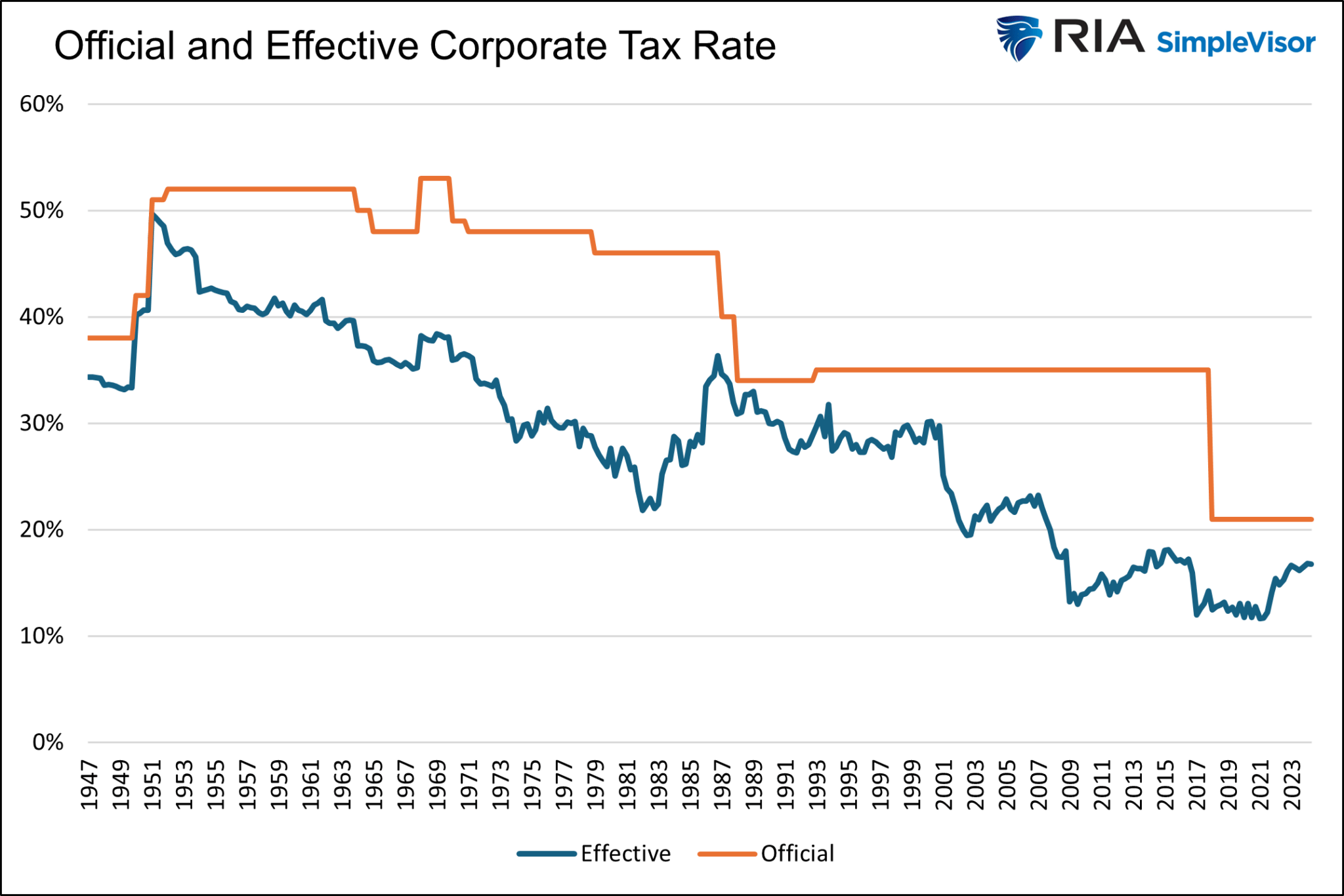
Like personal taxes, corporations have many loopholes. Thus, the effective tax rate can vary widely by company. Evaluating how tax rates affect corporate bottom lines in the aggregate is important but can be critical at a company level.
This article only addresses the proposals from the point of view of corporate profits. We do not opine on how they could impact the deficit or economy.
Donald Trump’s Tax Proposals
Trump’s current tax proposal calls for a tax reduction for corporations from 21% to 15%. However, the reduction would solely be for companies that make their products in America. Companies that “outsource, offshore or replace American workers” will not be eligible.
What’s unclear is whether companies can divide their revenue for tax purposes based on where goods are manufactured. Furthermore, how will companies providing services be taxed?
Also for consideration is the “Bonus Depreciation” tax break from the 2017 TCJA. The legislation allowed companies to depreciate 100% of equipment purchases in the year it was acquired. Previously, they could only write down the value of equipment over time according to its useful life.
The Institute of Taxation and Economic Policy (ITEP) analyzed the impact of the accelerated depreciation rule on 25 of the biggest beneficiaries (LINK). They write:
The federal statutory corporate income tax rate is 21 percent, which means that if corporations enjoyed no special breaks or loopholes at all, they would pay 21 percent of their profits in taxes. As a group these corporations used many kinds of tax breaks to drive their effective federal income tax rate down to 12.2 percent. For the whole group of companies, accelerated depreciation accounts for 86 percent of those tax breaks.
Some corporations have used accelerated depreciation to drive their effective tax rates down to single digits during this five-year period. These include Verizon (NYSE:VZ), Amazon (NASDAQ:AMZN), Walt Disney (NYSE:DIS), Con Edison, General Motors (NYSE:GM), Dish Network (NASDAQ:DISH), and others.
While the accelerated depreciation has been a boon to some companies, the amount a company can depreciate declines over time. In 2024, a company can only depreciate 60% of equipment costs versus 100% from 2018 to 2022. Each year forward, the amount drops by 20%. In 2027 and beyond, it will be phased out unless it’s extended.
Kamala Harris’s Tax Proposals
Harris’s proposal is more straightforward to analyze. She supports raising the corporate tax rate to 28% for all companies. In addition, she would like to increase the corporate stock buyback tax from 1% to 4%.
Under her plan, companies would see a 7% increase in tax rates which essentially claws back half of Trump’s 2017 TCJA tax legislation.
Congress ultimately has the power to change tax rates. Ergo, whether it is Trump or Harris, it will be hard to change the tax code if one of the two houses of Congress is the opposing political party. The chart below from Gavekal Research shows the possibilities.
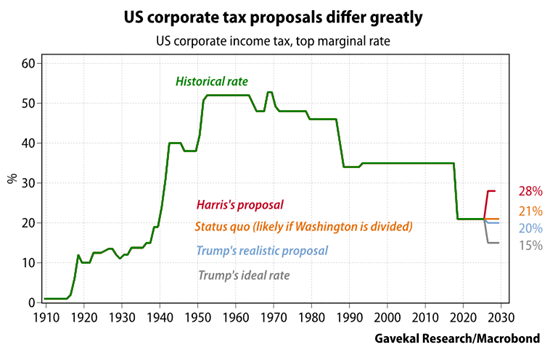
Analyzing The S&P 500 Companies
With some background on the candidate’s proposals, we now evaluate the constituents of the S&P 500 to assess the impact of the Trump tax cut. The analysis helps gauge which stocks are most at risk of tax hikes or could benefit from further tax reductions.
Our analysis is based on corporate tax data from 2010 to current for the 503 current S&P 500 stocks. To help improve the quality of the analysis, we only assessed companies with at least four years of earnings data before the Trump tax cuts and six years afterward. Further, we avoided companies with volatile earnings. That criteria narrowed the list to 306 companies.
Of this subset of the S&P 500, the average tax rate before the tax cut was 26.74%. Since then, it has been 17.37%. Almost 90% of the companies saw their effective tax rates decline. On average, the 306 companies’ earnings were 9.36% greater than they would have been.
We summarize the data for you because there are over three hundred companies.
The following table organizes the data by sector. Utilities were the apparent biggest beneficiary of tax cuts. This was partly from the bonus depreciation and recent tax incentives to promote green energy.
On the other side of the coin is real estate. The cut was not meaningful because these companies tend to pay very little taxes. As shown, the rest of the sectors tended to gravitate around the average.

The following table shows the largest stocks by market cap. We left out five stocks due to earnings volatility.

Who Pays If The Harris Plan Is Law
The following table lists the companies that saw an improvement of at least 20% to their bottom lines due to the 2017 change in the tax code. Some of these stocks may be at most risk if Harris’s tax plan to boost rates to 28% passes. Those with effective tax rates closer to 28% may be the least affected.
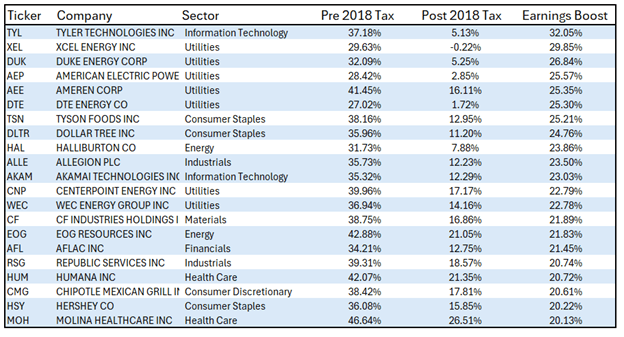
Part of the Harris plan is to raise the buyback tax rate from 1% to 4%. Doing so will weigh on the bottom lines of those perpetually buying back significant amounts of shares. Furthermore, some of these companies may find it more advantageous to increase their dividends instead of buybacks.
The following graph from Uptrends shows the top ten buyback programs of 2024. Clearly, Apple (NASDAQ:AAPL), META (NASDAQ:META), and Google (NASDAQ:GOOGL) may have the most to lose from the potential tax increase.

Who Wins If Trump’s Plan Is Enacted
Conversely, those with the highest effective taxes and domestic production capabilities may benefit the most. Given that we do not have data on production facilities, we can only share the companies with the highest effective post-2018 tax rates.
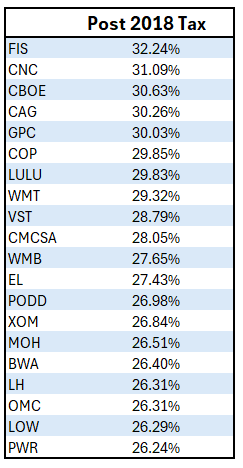
In addition to the potential tax cut, we must consider any changes to the bonus depreciation roll-off schedule. Trump could try to bring back the 100% depreciation in year one or stop the bonus depreciation percentage from declining.
To help us in this endeavor, we share the following table from ITEP with the biggest beneficiaries of the bonus deprecation.



Summary
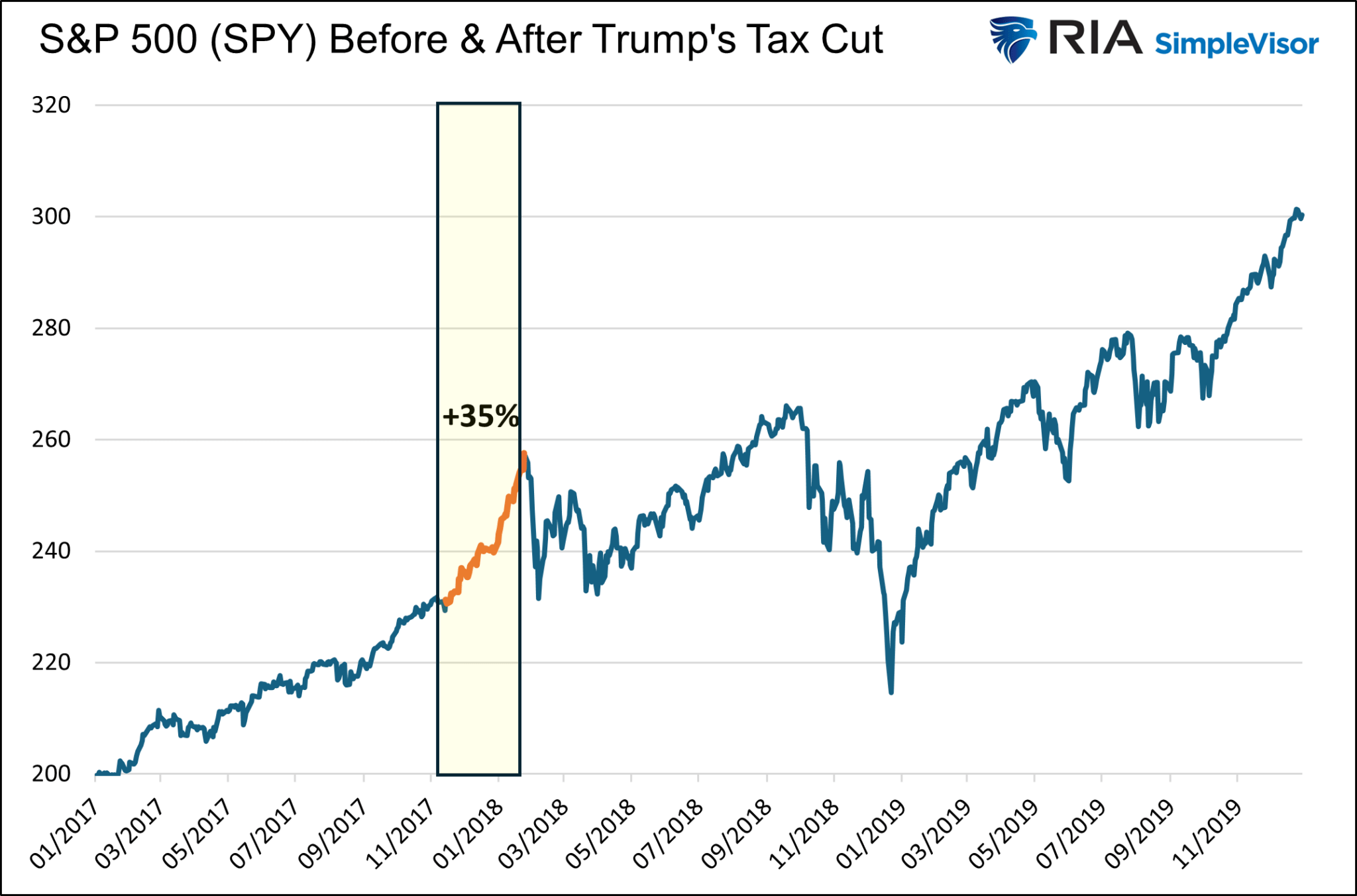
As we sit here today and assess the stock market and individual stocks from a political perspective, it appears a Trump victory may provide investors with more potential upside. We are solely basing the argument on their respective tax cut proposals.
The graph above shows that the S&P 500 rocketed by 35% in the two months following the passage of the legislation. Furthermore, the market rose before the legislation as investors gained confidence the legislation would pass Congress.
One can argue the gains were short-lived, as the market gave up its gains shortly after. Contrarily, higher corporate profits due to lower tax rates are an important factor driving the market significantly higher since 2017.
Original Post
